Cheese is alive!
There are many things that can be done to make cheese last longer. In all of its many steps from production to consumption, a cheese needs to be tended to and handled with care.
Cheesemakers work hard to produce and age cheese in a way that allows it to be enjoyed by the final consumer. Cheeses have different ways of aging, and many include some sort of mold in that process. Many times, those molds are intentional and expected, developing from cultures added during the cheesemaking process or from ambient molds present in the aging room. Other times they are not as desirable. Cheesemakers use various methods for dealing with unwanted molds or otherwise maintaining the rinds of their cheese in peak form. Parmigiano Reggiano, for example, is cleaned regularly by an automated brushing machine during its two-year aging so that its rind is the beautiful golden color that it is known for. Brushing, wiping, coating, even vacuuming are all methods used to help cheese develop and age properly.

Cheesemongers know how to handle cheese as well and are often wiping and brushing cheese, either right when the cheese arrives to them or after, whenever the cheese needs it. Remember, cheese is alive, and if handled with care and attention, it will live a long life, if neglected, it will suffer and die.
Cheese is most commonly purchased wrapped in plastic that traps gasses and doesn’t let cheese breathe, unless shopping at some cheese specific shops where it is wrapped in paper. When getting a cheese home, most cheeses are best served by being taken out of the plastic, wrapped with a cheese specific paper (usually wax or parchment paper) and then stored in a container inside the refrigerator. Molds that develop on the cut surface of a cheese are most commonly the ones that have been on the rind during its aging and can simply be cut off. The general rule of 1/4 inch trim works well, since it also addresses the rest of the cut surface that has likely oxidized and is no longer optimal.
When consuming cheese, it is always best to let the cheese come to room temperature and to let it breathe before starting.
While mold can be an indicator of the condition of a cheese, it does not mean the cheese is bad or past its prime. Modern technology and methods make it possible to sell a cheese with no mold, but those cheeses are typically treated with chemical preservatives and mold inhibitors, and even then, they can develop mold, given the right conditions. Cheeses made using more traditional methods are most likely to display mold from the beginning. Across the globe, you will find mold on good, handcrafted cheeses. It should be expected to appear and should not be cause for alarm. If you are unsure, please ask questions – we are happy to help!







